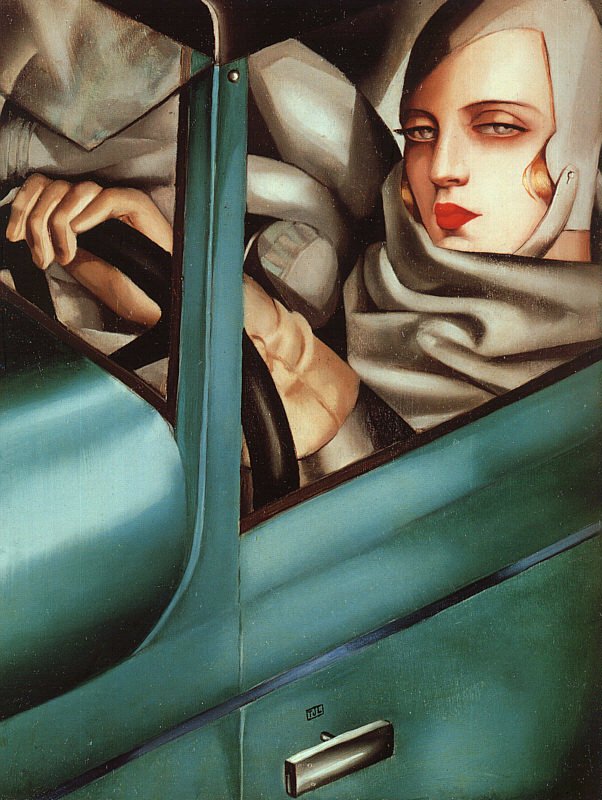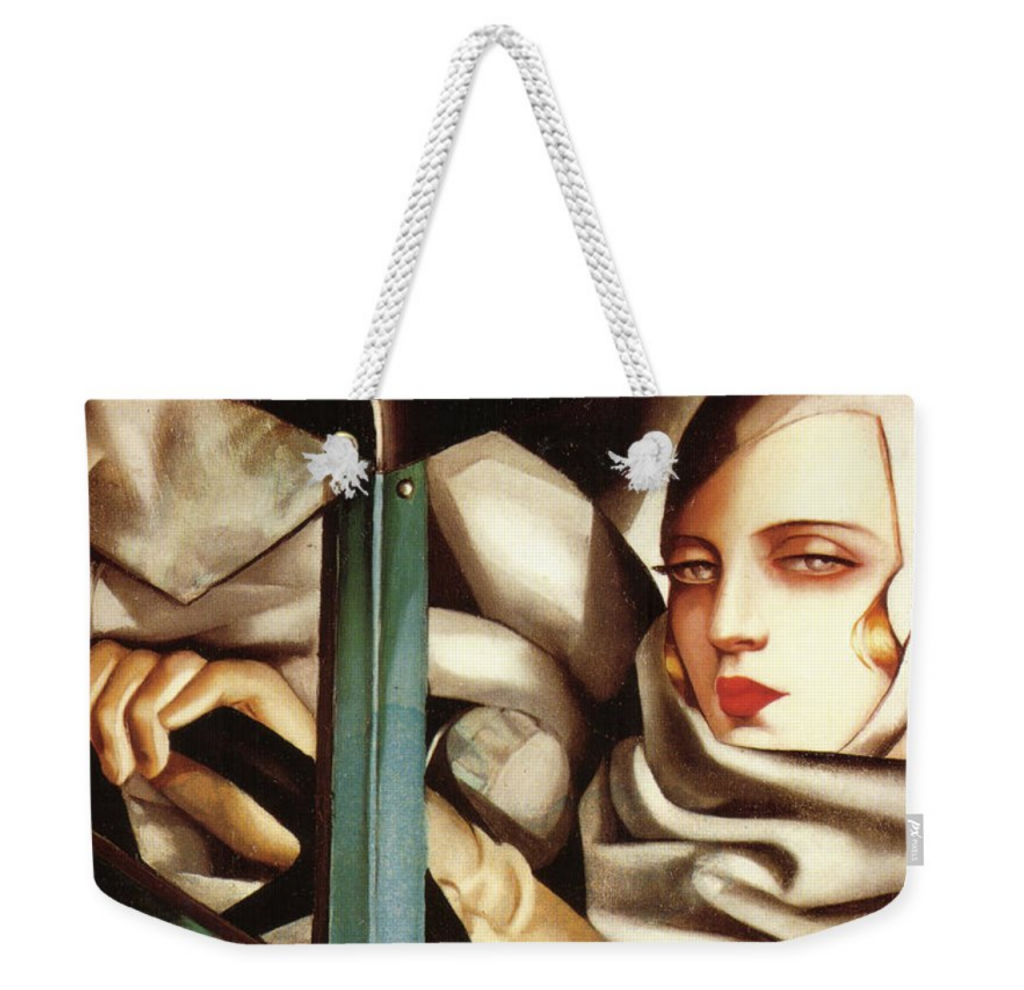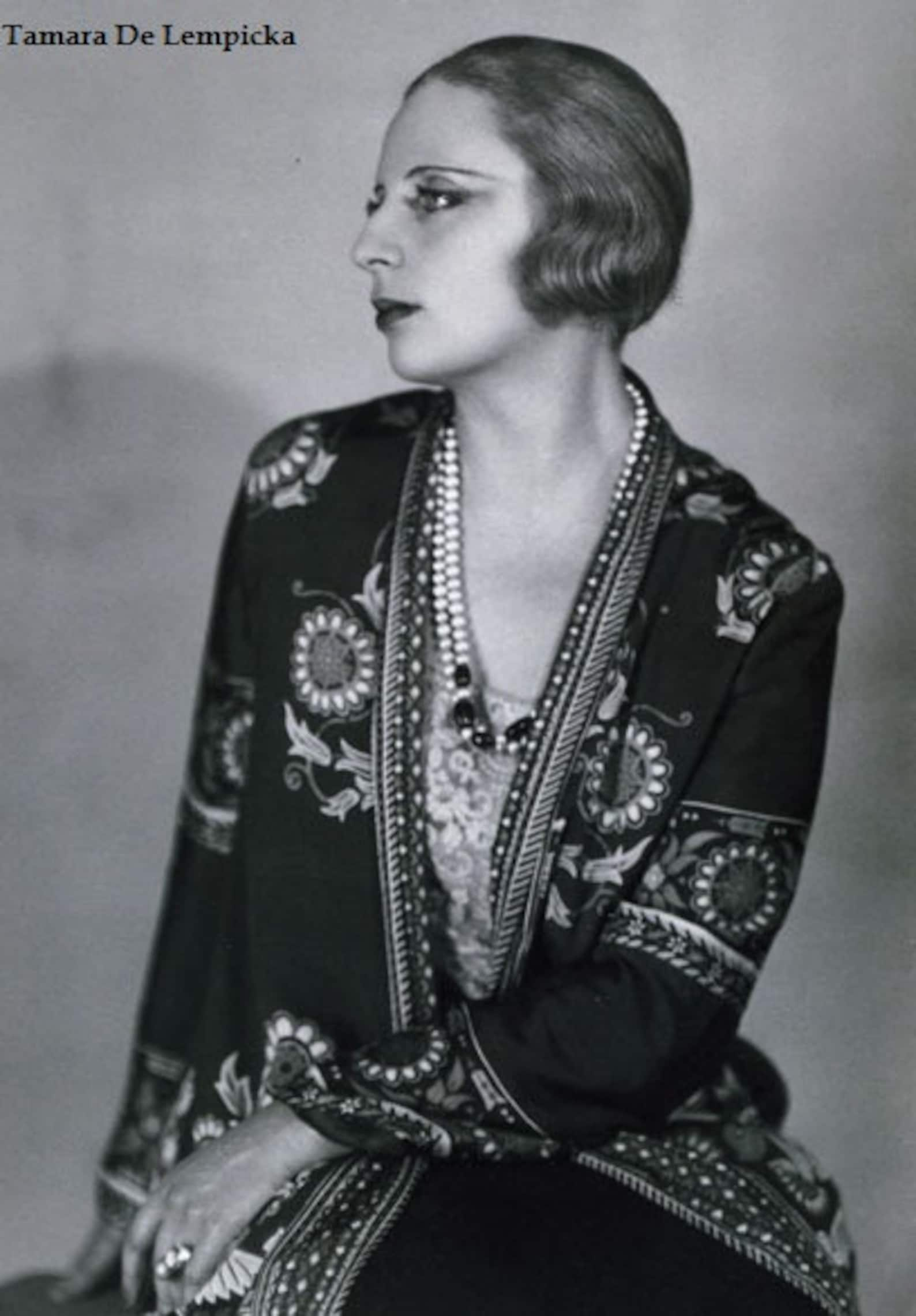
Tamara de Lempicka Green Bugatti Self Portrait Art Deco Etsy
"Autoportrait (Self-Portrait in the Green Bugatti)" is the best known Lempicka piece. (Tamara de Lempicka Estate, ARS 2022) The audacity to legitimize her own gaze — within her work, among.

Tamara de Lempicka nő ecsettel, Bugattival
Self-Portrait (Tamara in Green Bugatti) by Tamara de Lempicka, 1929, via Arthive The most famous artwork by Tamara de Lempicka is her self-portrait. It came as a result of a spontaneous meeting with the director of the German fashion magazine Die Dame. The director saw Tamara exiting her yellow Renault, wearing a matching dress and a hat and.

Why Not Add an ArtInspired Accessory to Your Fall Look? This Online
In 1925, Lempicka painted her iconic work Auto-Portrait (Tamara in the Green Bugatti) for the cover of the German fashion magazine Die Dame. As summed up by the magazine Auto-Journal in 1974, "the self-portrait of Tamara de Lempicka is a real image of the independent woman who asserts herself. Her hands are gloved, she is helmeted, and.

Homage of T. de Lempicka Tamara im grünen Bugatti i95629 80x110cm
DescribeThe artwork features a close-up view of a woman in the driver's seat of a car, framed by the open window of a vibrant green vehicle, potentially a Bu.

"SelfPortrait in Green Bugatti" (1925) by Tamara de Lempicka (1898
As a result of this, Autoportrait (Tamara in the Green Bugatti) is a true emblem of the revindication and emancipation of women in the early 20th century. Tamara de Lempicka is seen as a strong and fashionable lady, confident and comfortable with herself, poetically conveying a very clear message: she is a woman, capable of driving her life.

homage to T. de Lempicka Tamara in the green Bugatti 80x110 cm
Self-portrait (Tamara in a Green Bugatti) is a painting of Tamara de Lempicka (colloquial name of Tamara Łempicka), which captures her at the very rise of her career and became her iconic image. Although this portrait also has a grain of fiction, just as her scandalous biography, which she reshaped to her discretion. Bugatti's immodest charm

In 1925, Lempicka painted her iconic work AutoPortrait (Tamara in the
Tamara de Lempicka Autoportrait (also known as Tamara in a Green Bugatti), 1929, oil on canvas. By Tori Campbell. De Lempicka was born into a wealthy family: her father, Boris Gurwik-Górski, was a Russian Jewish attorney and her mother, Malwina Decler, was a socialite. She was sent to boarding school in Lausanne, Switzerland in 1911, but.

SelfPortrait in the Green Bugatti, Tamara de Lempicka, 1925 [1280 x
Tamara de Lempicka is painted in a green Bugatti, a luxurious car at the time, in reality, she owned a small yellow Renault which she decided to replace for the self-portrait in order to convey a sense of wealth and high status. After all, she was now simultaneously playing the roles of both artist and socialite at a time when the Bohemian.

SelfPortrait In The Green Bugatti by Tamara de Lempicka Printed on
Private Collection, Switzerland. Autoportrait (Tamara in a Green Bugatti) is a self-portrait by the Polish artist Tamara de Lempicka, which she painted in Paris in 1928. It was commissioned by the German fashion magazine Die Dame for the cover of the magazine, to celebrate the independence of women. It is one of the best-known examples of Art.

Adult Jigsaw Puzzle Tamara de Lempicka Tamara in the Green Bugatti
Autoportrait (Tamara in a Green Bugatti), one of the most well-known Tamara de Lempicka paintings, was created for the front of the German fashion and style publication Die Dame in 1929. This depicted her driving a Bugatti sports vehicle while donning leather headgear, mittens, and a grayish scarf, a depiction of chilly elegance, individualism.

Larger Size* Portrait in the green bugatti Framed Print by Tamara de
Tamara de Lempicka can be seen, in some way, as the emancipated woman of the 20s par excellence. In her Self-Portrait in a Green Bugatti, de Lempicka paints.

Pin auf Artiful
Autoportrait (Tamara in a Green Bugatti) is Tamara Łempicka's most famous and most often reproduced work.. Although the artist usually signed her works as 'de Lempicka', this time she also used the Junosza coat of arms which belonged to her husband Tadeusz Łempicki. By portraying herself as sitting in a car - a vehicle which is.

TAMARA DE LEMPICKA. Autorretrato en un Bugatti verde. 1929. アート
Despite her usual inspirations, the one painting that could be called Lempicka's most famous is in fact a self portrait. "Autoportrait (Tamara in a Green Bugatti)", painted in 1929, was originally commissioned by the German fashion magazine Die Dame for an issue about women's independence. The painting shows Lempicka, seated casually with an icy gaze, in the driver's seat of an.

"Tamara in the Green Bugatti", 1929 selfportrait by Polish Art Deco
In 1929, Lempicka painted one of her best-known works, Autoportrait (Tamara in a Green Bugatti), for the cover of the German fashion magazine Die Dame. This showed her at the wheel of a Bugatti racing car wearing a leather helmet and gloves and wrapped in a gray scarf, a portrait of cold beauty, independence, wealth, and inaccessibility.

Self Portrait In A Green Bugatti Framed Print by Tamara de Lempicka
Tamara de Lempicka is the main artist of the art deco movement. Her self-portrait in a green Bugatti was famously on the cover of Die Dame, a Paris fashion magazine.This episode is about her early life, her family, her infamous partying among the elite, and her impressive career and legacy.

Tamara De Lempicka Tamara in the Green Bugatti Self Etsy
Lempicka spent the last two years of her life in Cuernavaca, Mexico. As the wheel turned yet again, interest began to revive in her paintings in the 1970s, most notably after the 1972 retrospective exhibition 'Tamara de Lempicka from 1925-1935' at the Palais du Luxembourg in Paris. By 1990, ten years after her death, Lempicka's early Art Deco.